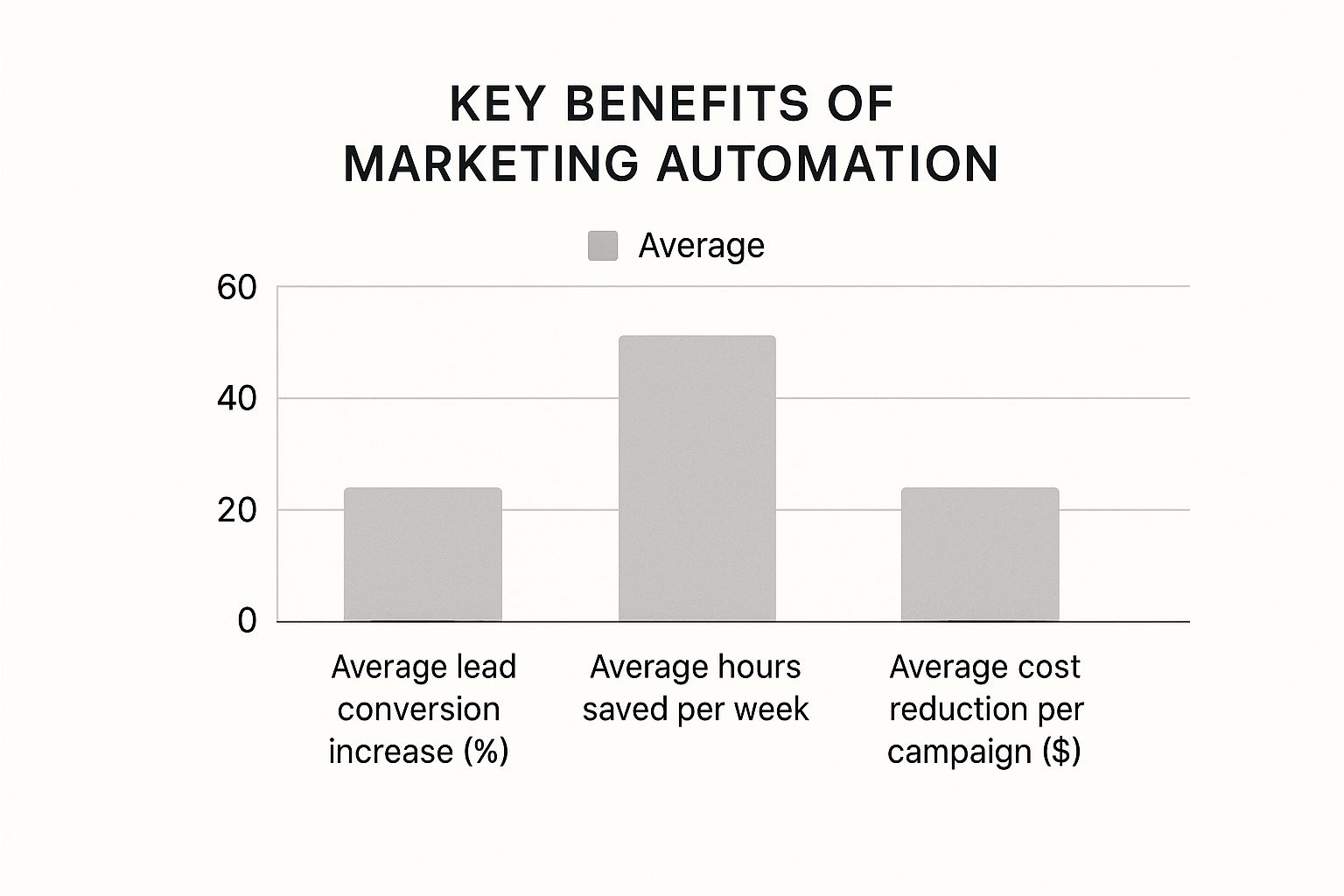Understanding What Marketing Automation ROI Really Means
Marketing automation promises increased efficiency and higher revenue. But what does marketing automation ROI really mean in practical terms? It's about more than simply subtracting the cost of your automation platform from the revenue it generates. True marketing automation ROI takes into account a wider range of benefits.
This means looking beyond immediate financial gains and considering the long-term strategic advantages. These advantages accumulate over time, producing substantial returns down the line.
For instance, consider automating your lead nurturing process. At first, you might track success by the increase in qualified leads. But a well-designed automated lead nurturing workflow also frees up your team. This allows them to concentrate on higher-value activities, like strategic planning or personalized outreach. This, in turn, indirectly drives further revenue growth.
Consistent, personalized nurturing also builds stronger relationships with potential customers. This contributes to increased customer lifetime value, a crucial factor in long-term profitability. This broader perspective reveals the real power of marketing automation ROI.
Looking Beyond the Numbers
Traditional ROI calculations often miss the mark when assessing marketing automation. They struggle to capture less tangible, yet equally valuable, benefits like improved operational efficiency and a better brand reputation. Marketing automation streamlines tasks that were once manual and time-consuming.
This allows your marketing team to concentrate on strategic initiatives that drive innovation and growth—a benefit hard to quantify, but vital for long-term success.
Moreover, personalized and targeted campaigns, powered by automation, enhance the customer experience. This can lead to increased customer loyalty and positive word-of-mouth marketing. These “soft” benefits, though difficult to measure directly, are crucial for maximizing marketing automation ROI.
As your processes become more streamlined and efficient, your team can dedicate more time to developing innovative campaigns and fostering stronger customer relationships. This holistic approach distinguishes successful automation programs from costly failures.
Marketing automation has shown significant potential for generating substantial returns. In fact, many organizations using marketing automation tools see positive results within a year. According to recent statistics, 76% of companies using marketing automation see a positive ROI within one year. This indicates that the vast majority of businesses find marketing automation to be a worthwhile investment, streamlining processes and improving personalization. Learn more about marketing automation statistics. This success is often due to automation's ability to free up resources for more strategic work. Understanding this multifaceted impact is essential for developing a realistic and effective marketing automation strategy.
Tracking Metrics That Actually Drive Marketing Automation ROI
Marketing automation ROI isn't about superficial metrics like open rates or click-throughs. These offer a glimpse into engagement, but they don't reveal the complete picture. True ROI comes from measuring the impact of automation on your bottom line. This means focusing on metrics that directly correlate with revenue generation and business growth.
Beyond Vanity: Metrics That Matter
Lead conversion rate is a critical indicator. How many of those automated leads become paying customers?
Customer lifetime value (CLTV) is another key metric. A well-nurtured lead, guided through the sales funnel by automation, can transform into a loyal, long-term customer. This results in higher CLTV and stronger ROI. You might be interested in: How to master B2B sales lead generation.
Effective marketing automation also reduces the cost per acquisition (CPA). By streamlining processes and targeting the right audience, you spend less on acquiring each new customer, directly contributing to a healthier ROI.
The infographic below visualizes three key benefits of marketing automation: average lead conversion increase (%), average hours saved per week, and average cost reduction per campaign ($).

As the infographic shows, marketing automation can significantly boost lead conversions, free up valuable time for your team, and lower overall campaign costs. These combined effects contribute powerfully to maximizing your marketing ROI.
To provide a more detailed comparison of key metrics, the following table outlines measurement difficulty, impact level, typical improvement range, and time to see results:
Essential Marketing Automation ROI Metrics Comparison: A comprehensive comparison of key metrics showing measurement difficulty, impact level, and typical improvement ranges.
| Metric Type | Measurement Difficulty | ROI Impact Level | Typical Improvement Range | Time to See Results |
|---|---|---|---|---|
| Lead Conversion Rate | Low | High | 10-30% | Short Term |
| Customer Lifetime Value (CLTV) | Medium | High | 15-25% | Mid-Long Term |
| Cost Per Acquisition (CPA) | Low | High | 10-20% | Short Term |
| Website Traffic | Low | Medium | 20-50% | Short Term |
| Sales Qualified Leads (SQLs) | Medium | High | 15-25% | Mid Term |
This table illustrates how focusing on the right metrics, from readily measurable ones like lead conversion rate and CPA to longer-term indicators like CLTV, provides a comprehensive view of marketing automation's impact. Understanding these metrics helps optimize campaigns and demonstrate clear ROI.
Advanced Tracking for Deeper Insights
Basic metrics only scratch the surface. Savvy marketers use multi-touch attribution to understand how different automation touchpoints contribute to conversions. This helps pinpoint which automated actions are most effective and optimize campaigns for maximum impact.
Behavioral scoring is another crucial aspect. By assigning points to specific prospect actions, you identify high-potential leads and prioritize your automated efforts. This focus on quality leads significantly improves conversion rates and overall ROI. When focusing on marketing automation ROI, consider how paid channels can be integrated; read more about optimizing your Google PPC campaigns for maximum ROI. This targeted approach ensures you're not just automating activities, but driving real business results. This strategic use of automation differentiates a profitable program from an expensive experiment.
Building Smart Marketing Automation ROI Strategies On Any Budget
Exceptional marketing automation ROI isn't just about big budgets. It's about smart planning and efficient execution. Many successful companies achieve impressive returns without overspending. They do this by focusing on key strategies, like carefully choosing the right platforms and avoiding common pitfalls. These pitfalls can negatively impact ROI before you even begin.
Platform Selection and Cost Optimization
Choosing the right marketing automation platform is crucial for maximizing ROI. A platform packed with features you don't need drains your budget. Instead, focus on features aligning with your specific needs and able to scale with your company's growth. This flexible approach ensures you’re paying for valuable functionality, not just a hefty price tag.
For example, if your primary focus is email marketing and lead nurturing, prioritize platforms specializing in those areas. Mailchimp might be a good starting point. Don't overspend on platforms with extensive social media management features if you're not ready to use them. You might be interested in: How to master lead generation with automation. This targeted platform selection optimizes spending and sets the stage for strong ROI.
Workflows That Evolve With Your Business
Adaptable workflows are key to maximizing your automation investment. As your business and marketing strategies grow and evolve, so should your automated workflows. This scalability prevents costly overhauls or platform migrations later on.
Start with simple, automated workflows for core processes like welcome emails and lead nurturing. Then, add more sophisticated workflows as your needs and budget allow. This measured, adaptable approach ensures consistent value from your automation investment while minimizing unnecessary expenses.
Maximizing Every Automation Dollar
To truly maximize ROI, think strategically about resource allocation and feature rollouts. Don't implement every feature at once. Prioritize the ones offering the quickest wins and align with your immediate goals. This focused approach helps demonstrate early ROI and secures buy-in for future automation investments.
Additionally, establish clear performance indicators and regularly track your progress. This data-driven approach allows you to identify successes, failures, and adjust your strategy accordingly. Continually optimizing your automation efforts ensures every dollar invested contributes to your overall marketing ROI. This ongoing optimization is what separates successful, high-ROI automation programs from costly, underperforming ones.

Mastering Lead Nurturing For Maximum Marketing Automation ROI
Lead nurturing offers a significant opportunity to maximize your marketing automation ROI. However, many businesses fall short of realizing its full potential, often relying on generic email sequences that prospects often ignore. The key is understanding the difference between high-converting nurture campaigns and those that fall flat.
Building Effective Automated Workflows
Effective lead nurturing relies on creating automated workflows that efficiently guide prospects through your sales funnel. This requires minimal manual intervention, allowing your team to concentrate on high-value activities. You might be interested in: How to master lead nurturing with sales automation. These workflows should seamlessly move leads from initial contact to qualified opportunity.
For example, consider a prospect who downloads a whitepaper from your website. An automated workflow could then trigger a series of personalized emails, each providing valuable content related to the whitepaper’s topic. This focused approach keeps your brand top-of-mind and positions you as a valuable resource.
Personalization and Behavioral Triggers
Personalized messaging is essential for effective lead nurturing. Generic emails often land in spam folders. By tailoring your messages to individual prospect needs and interests, you significantly increase engagement and conversion rates.
Additionally, leveraging behavioral triggers is crucial. These triggers initiate automated actions based on specific prospect activities. For example, if a prospect visits a specific product page on your website, a trigger could automatically send them a targeted email with further information on that product. This relevant and timely approach maximizes the impact of your automation efforts.
Scoring Models and the Human Touch
Lead scoring helps you prioritize your most promising leads. By assigning points based on various criteria, such as engagement level and demographic information, you can focus your energy on those most likely to convert.

While automation is crucial for efficiency, never underestimate the importance of the human touch. Even in today’s automated world, authentic human interaction is invaluable. This involves incorporating opportunities for personalized outreach, such as phone calls or handwritten notes, for key prospects. This careful balance between automation and human connection is essential for driving conversions in a competitive marketplace. For small businesses seeking to implement marketing automation, finding budget-friendly yet effective strategies is vital. Consider reading about Marketing Automation for Small Business. This blend ensures your automated efforts feel helpful and authentic, not robotic or impersonal, ultimately maximizing your marketing automation ROI by building stronger, more meaningful relationships with your leads.
Measuring Long-Term Marketing Automation ROI Success
While short-term gains from marketing automation are important, the real impact lies in long-term transformation. This value comes from the compounding effects of automation, like improved customer retention and stronger brand loyalty, which solidify a more competitive market position.
Beyond Quarterly Reports: The Full Spectrum of Benefits
Truly understanding the long-term ROI of marketing automation requires looking beyond quarterly reports. We need analytics frameworks that capture not just immediate financial returns, but also the less tangible, long-term advantages. Think operational efficiencies, stronger customer relationships, and increased brand recognition.
For example, imagine automating your customer onboarding process. Initially, you might see improved customer satisfaction scores. Over time, this streamlined experience can lead to lower churn rates and higher customer lifetime value.
Building Automation Programs That Deliver Increasing Returns
Industry leaders build marketing automation programs for lasting success. They adopt strategic planning and measurement beyond simple cost-benefit analysis, focusing on strategies that adapt to changing markets.
One key strategy is customer segmentation and personalized messaging. Tailoring automated communications to specific customer groups builds stronger relationships and increases engagement, leading to higher conversion rates and improved ROI over time.
Adapting to Change and Maintaining Strategic Advantages
The marketing landscape is always changing. Your marketing automation strategy must adapt. Regularly review your automated workflows, making adjustments based on performance data and market trends. This flexibility is critical for long-term ROI success.
Constant evolution keeps your automation programs from stagnating, ensuring they continue delivering increasing returns. Platforms like Salesloop.io provide the flexibility and adaptability needed in a changing market. By consistently refining and optimizing your automation efforts, you maintain a strategic advantage, separating leaders from followers.
Avoiding Marketing Automation ROI Killers That Destroy Returns

Even with the best-laid plans, your marketing automation ROI can suffer. Common pitfalls can derail even the most promising strategies. These range from overwhelming your audience with too much automation to barely scratching the surface of your chosen platform's potential. Recognizing and addressing these ROI killers is essential for long-term success.
Over-Automation and the Delicate Balance
One of the biggest mistakes is over-automating your marketing efforts. While automation streamlines tasks and boosts efficiency, going overboard can backfire. Excessive automation can make your marketing feel impersonal and robotic, driving prospects away instead of drawing them in. This often leads to lower conversion rates and a disappointing ROI.
For example, imagine being bombarded with irrelevant emails after a single, minor interaction with a brand. It's off-putting, to say the least. This highlights the importance of a balanced approach. Finding the sweet spot between automated efficiency and authentic human connection is key.
Platform Under-Utilization: A Wasted Investment
Another major ROI killer is under-utilizing your marketing automation platform. Investing in a powerful platform and then using only a fraction of its capabilities is a waste of resources. It’s like buying a race car and only using it for grocery runs.
Many platforms, like Salesloop.io, offer a wealth of features. These range from lead scoring and segmentation to personalized email campaigns and in-depth analytics. Failing to leverage these tools means you’re leaving potential ROI on the table.
Setting Realistic Expectations and Timelines
Building a strong marketing automation ROI takes time and effort. Expecting overnight success is unrealistic and often leads to disappointment and the premature abandonment of a potentially successful strategy.
Setting clear expectations with stakeholders from the start is critical. Communicate realistic timelines for measurable results and highlight the long-term advantages of automation. This transparency fosters trust and allows for adjustments along the way, turning struggling automation programs into profitable ventures.
Recognizing Warning Signs and Taking Corrective Action
Regularly monitoring your key performance indicators (KPIs) is vital for catching potential problems early. Declining engagement rates, lower conversion rates, and a decrease in customer lifetime value are all red flags. These warning signs indicate your automation efforts aren't delivering the expected ROI.
When these red flags pop up, swift corrective action is essential. This might involve tweaking your automated workflows, refining your messaging, or re-evaluating your overall automation strategy. Addressing these issues promptly can prevent further damage and pave the way for a healthier ROI.
Let's take a closer look at some common challenges, their impact, warning signs, and solutions:
The following table outlines common challenges that can negatively impact your marketing automation ROI, along with practical solutions and preventative strategies.
Marketing Automation ROI Challenges and Solutions
| Common Challenge | Impact on ROI | Warning Signs | Proven Solutions | Prevention Strategy |
|---|---|---|---|---|
| Over-Automation | Reduced engagement and conversions | Decreased open and click-through rates, increased unsubscribe rates | Implement personalized messaging, segment audiences based on behavior, incorporate more human touchpoints | Develop a clear automation strategy with defined goals and target audience segments |
| Platform Under-Utilization | Missed opportunities for optimization and lead nurturing | Low lead scores, stagnant sales pipeline, lack of data-driven insights | Leverage all platform features, invest in training and support, regularly review campaign performance | Conduct a thorough needs assessment before selecting a platform, ensure adequate training for all users |
| Unrealistic Expectations | Premature abandonment of strategy, wasted resources | Lack of progress towards goals, frustration among stakeholders | Set clear and achievable goals, communicate realistic timelines, track and report on progress regularly | Define KPIs and success metrics upfront, establish a feedback loop with stakeholders |
| Ignoring Warning Signs | Declining performance, lost revenue | Decreased website traffic, lower conversion rates, reduced customer lifetime value | Analyze data to identify root causes, adjust automation workflows, refine messaging and targeting | Regularly monitor key metrics, establish a process for addressing performance issues |
By understanding these common challenges and implementing the suggested solutions, you can significantly improve your marketing automation ROI and achieve your desired business outcomes. Remember, effective marketing automation is about finding the right balance between automation and the human touch, leveraging your chosen platform's full potential, setting achievable goals, and constantly adapting your strategy based on data and feedback.
Key Takeaways
Your journey to mastering marketing automation ROI begins with a solid understanding of its true meaning. It's not just about immediate financial gains, but the long-term advantages that create a sustainable and profitable business. These include smoother operations, better customer relationships, and a more competitive market position.
Building a Roadmap for Success
Achieving exceptional marketing automation ROI requires a strategic roadmap, grounded in data-driven insights and practical expectations. Begin by focusing on the most important metrics: lead conversion rate, customer lifetime value (CLTV), and cost per acquisition (CPA). These metrics provide a concrete way to measure the effectiveness of your automation efforts.
This means implementing advanced tracking methods like multi-touch attribution and behavioral scoring. These techniques offer valuable data about which automation touchpoints are most influential in driving conversions. Understanding these complexities will help you refine your strategies and optimize every step of the customer journey.
Strategies for Every Budget
Developing a smart marketing automation strategy isn't about large expenditures; it's about smart investments. Selecting the right platform—one that aligns with your specific needs and can scale with your business—is critical. Focusing on workflows that are flexible and adaptable allows your automation efforts to grow along with your business, maximizing your ROI.
In addition, implementing cost-optimization techniques like prioritizing feature rollouts and strategically allocating resources helps you get the most from every dollar spent on automation. This thoughtful approach, combined with consistent monitoring and optimization, turns marketing automation from a potential expense into a powerful engine for profitability.
Lead Nurturing: The Heart of Automation
Lead nurturing is the core of effective marketing automation. It transforms potential customers into engaged buyers, driving conversions and increasing ROI. By developing personalized nurture campaigns that are triggered by specific behavioral cues, you can deliver relevant and timely messages, significantly boosting their impact. Finding the right balance between automated efficiency and a human touch is essential for building genuine connections and driving conversions.
Sustaining Long-Term ROI
Maintaining long-term success involves more than simply chasing short-term gains. It requires a framework that measures the full range of automation's benefits, from operational efficiency to market advantages. This means focusing on customer retention, developing brand loyalty, and leveraging the strategic opportunities that automation provides. By continuously adapting your strategy to market shifts and refining your automated processes, you ensure that your marketing automation continues to provide growing returns over time.
Ready to transform your sales outreach and unlock the true potential of marketing automation? Discover how Salesloop.io can empower your team to scale outreach, increase conversion rates, and accelerate pipeline growth.





